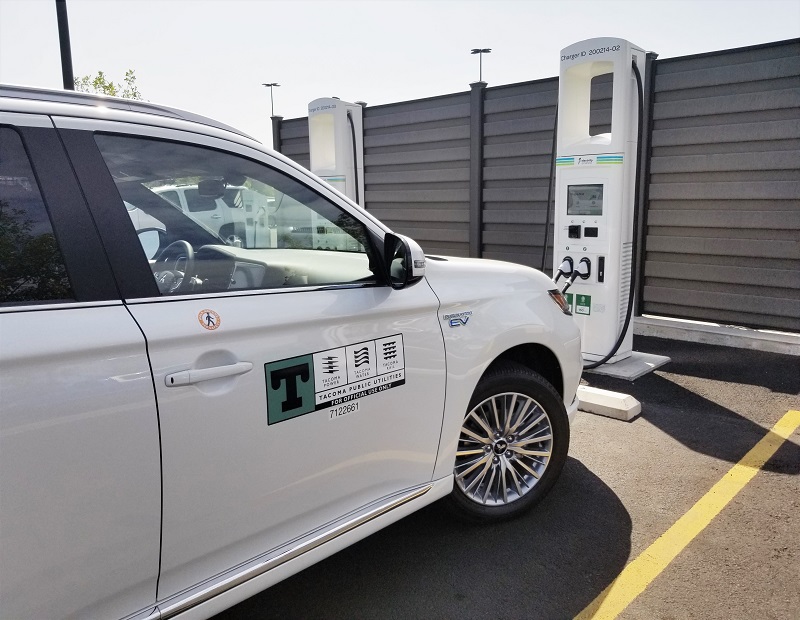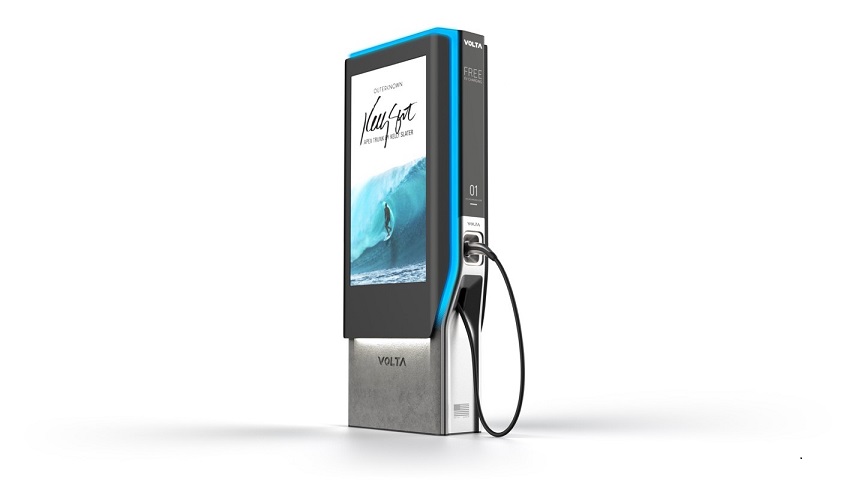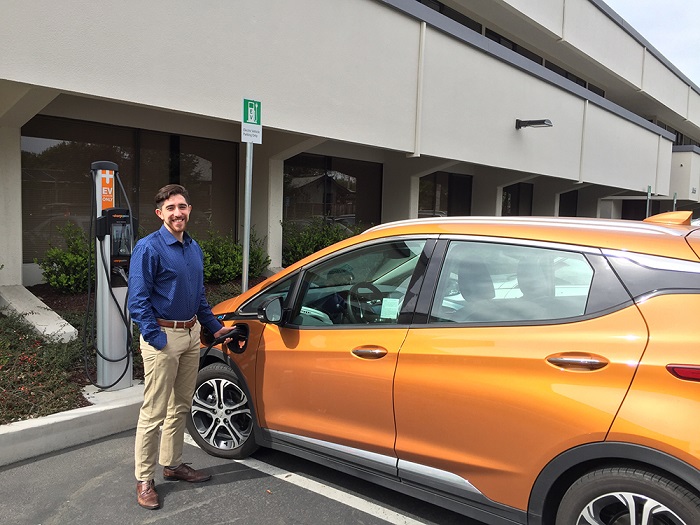EV Stations Spark Broad-Based Change
Electric vehicles are gaining traction nationwide. Should you consider installing charging stations at your properties?

Image courtesy of Walmart and Electrify America
As EVs continue to grow in popularity, the need for electric charging stations is also growing and commercial real estate owners and managers are helping lead the charge to make them available for tenants, shoppers and visitors at office buildings, retail centers, big-box stores, hotels and multifamily properties. EVs are expected to make up nearly 60 percent of the light vehicle market in the U.S. by 2030, and more electric cars were sold in the U.S. in the first half of 2019 than all of 2016.
Industry leaders are embracing the EV by making charging stations available across large portfolios:
- Simon Property Group now has more than 645 EV charging station at 110 properties in 20 states. The company has been installing them for nearly a decade, partnering with EVgo and more recently with Electrify America. In May 2018, Simon and Electrify America agreed to install charging stations for EVs and plug-in hybrids at more than 30 Simon centers, including King of Prussia in Philadelphia, Florida Mall in Orlando, Fla., and Gulfport Premium Outlets in Gulfport, Miss.
- Walmart was also an early adopter, installing its first EV charging stations almost 10 years ago. Working with Electrify America, the retail chain offers more than 120 plus ultra-fast EV charging station at Walmart locations in 34 states.
- Walgreens provides EV charging stations at about 400 locations. The stations feature either a high-speed DC charger that can add 30 miles of range in about 10 minutes or a level 2 charger that can add up to 25 miles of range per hour of charge.
- More than 3,137 EV Level 2 charging stations are available at Marriott hotels across the U.S.
Staying competitive
For some companies offering charing stations fits in with their own sustainability goals. For most, it also gives them a competitive edge.
“EV charging is an amenity. We are seeing it in a lot of Class A buildings. They are almost required to do it to stay competitive,” said Cara Carmichael, a principal at Rocky Mountain Institute and co-author along with Angelique Fathy of a recent report and blog post, Why Building Owners Should Care About Increasing EV Adoption.
At 71 S. Wacker, a 1.5 million-square-foot trophy tower owned by The Irvine Co. in Chicago’s West Loop, EV stations provide both a competitive edge and an amenity. “We’re a Class A trophy building driven by amenities,” said Jeff Venable, vice president of JLL’s property management group in Chicago and the general manager of the LEED Platinum tower.

Image courtesy of Volta
The building has had six EV charging stations in the parking garage for the past three years. An EV owner can charge for free for the first four hours, which is often enough these days, Venable noted, because battery charges last longer and many Tesla owners are charging at home.
While some states like California and municipalities like San Francisco are addressing EVs and the need for charging stations in commercial properties, the market is the key driver, said Sean Denniston, senior project manager at the New Buildings Institute in Portland, Ore.
“If you don’t have EV charging, some won’t rent,” Denniston said. “As that becomes a larger and larger portion of the rental market, it isn’t just about Teslas anymore. These are mass market cars now,” “You could be really limiting your tenant pool, your ability to be considered Class A and getting the top tier of tenants look at your property.”
John Bozeman, director, government and industry affairs at BOMA in San Francisco, noted that EV charging stations have been in BOMA San Francisco member building garages for years. “The impetus to install them usually is a combination of factors including environmental sustainability, tenant and public demand, and a future focus on increased EVs on the road,” he said.
Multifamily at the forefront

Image courtesy of Charlsie Chang
In New York City, Mary Serafy, managing director at BRP Cos., a developer specializing in affordable housing, workforce and market-rate multifamily properties, reported that nearly all their properties have EV charging stations and the demand is growing. She noted that attended parking lots at their NYC properties are required to have 20 percent of the spaces have charging stations.
Simon Aftalion, development director at Markwood Enterprises, a Beverly Hills, Calif.,-based real estate investment, management and development firm with multifamily properties in Los Angeles and New York City, said his firm has five Los Angeles-area developments that will have charging stations, including 82 EV stations at the 53-unit, mixed-use Santa Monica Barrington. They plan on making at least 20 percent of the parking spaces at those communities available for EV charging now and providing the ability to retrofit all spaces for EV charging in the future.
“Our EV offerings provide the opportunity for residents to go electric, which is typically rare in the rental world. Many of the rental communities in Los Angeles that do offer EV have limited stalls, making the option to drive an electric car less accessible to a wide majority of Angelinos,” Aftalion said.
Denniston said that there are no standards set yet for paying for charging at a multifamily property. Some building owners are looking at renters paying an extra fee for a charging space. Others are using key fobs that track how much electricity is used while the renter parks in the space.
Denniston also noted the costs of EV chargers have come down quite a bit, adding they could be as low as a few hundred dollars to mount the charging station on a post and connect to a power source. “It’s a surprisingly low level of capital investment up front,” he said.
In their recent blog, Carmichael and Fathy of RMI looked the cost of office workplace charging, noting that if not properly managed, EVs could increase energy costs 45 to 89 percent at an average-sized office property of about 100,000 square feet.
“With the right strategies in place—such as submetered or managed charging stations, and syncing charging stations with the building management system— building owners can take charge (so to speak) of their energy costs and continue to provide the desired amenity of charging stations while supporting the acceleration of EV adoption and decarbonization. This is a key part of the future of grid interactive buildings,” the two write in their report.
“We found if a building of 100,000 square feet with a fairly efficient use profile has 50 EV charging stations all utilizing typical use patterns, 50 was pretty much the break-even point that would double their demand charges,” Carmichael said. “If everybody shows up and plugs in at the same time, assuming the landlord is paying the bills directly, this could present a big risk if not tracking separately.”
Carmichael said at the very least building owners should submeter the EV charging stations separately to know how much the EVS are using and how much the charging costs. Better options are managed charging, allowing the utility or a third party to remotely control vehicle chargings to better correspond with the grid needs, or syncing the charging stations with the building management systems to lower the overall peak demand. For example, syncing EV charging to when solar is generating. The idea is to reduce demand charges for the building owners while also optimizing energy use for the grid.
“We don’t want the outcome to be building owners saying it’s too complicated,” she said. “There are opportunities for them to manage risk in different lease scenarios.”
State and local mandates

California state capitol, Sacramento. Image courtesy of Wil Stewart on Unsplash
For many building owners, the choice whether or not to install EV charging stations –or prepare spaces for future EVs – has been taken out of their hands by state and/or municipal governments. And some cities, like San Francisco, have tougher requirements, known as reach codes, than their state building codes. Fathy said the current guidelines in California are for a multifamily property with at least 17 units, 3 percent of the parking spaces must be EV-capable.
But San Francisco’s mandate that is 100 percent of new or redeveloped multifamily spaces must be EV-capable. For commercial properties, California requires 5 percent to be EV-capable while San Francisco sets it at 10 percent either EV capable or EV-ready with a conduit. Oakland requires 10 percent of multifamily and commercial properties to be EV ready and 90 percent EV-capable.
(EV-capable means the space must be linked to an electrical panel with sufficient capacity and have a dedicated branch circuit for future completion. EV ready requires the space to be fully wired with the conduit and electrical panel capacity.)
Requiring property owners to have EV-capable spaces will make it less expensive to add charging stations as the market for EVs grows, saving an owner about $5,000 per space to add charging later, Denniston said. In a state like California, which already has the highest number of electric vehicles and a goal of having 5 million EVs on the roads by 2030, pre-wiring parking spaces for charging infrastructure could result in retrofit cost savings of as much as $374 million between 2020 and 2025, according to the California Air Resources Board.
In Oregon, 5 percent of commercial and multifamily building parking spaces needed to be EV capable, Fathy said. But Oregon Gov. Kate Brown signed legislation in July requiring 90 percent of all vehicles in the state to be emissions-free by 2035, which will require installations of more charging stations to service them so watch for those regulations to be tightened.







You must be logged in to post a comment.